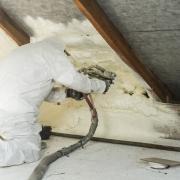The Benefits of Insulation and Weather Proofing Your Home
Investing in insulation and weather proofing your home can help you save on utility bills, reduce your carbon footprint, and increase the value of your home. There are a few different kinds of insulation, including Blown-in insulation, spray foam, and rigid fibrous or fiber insulation.
Blown-in insulation
Adding insulation is a great way to make your home more comfortable and reduce your energy bills. In fact, insulating your home can save you up to 15% on your heating and cooling costs.
Blow-in insulation is a type of insulation that is literally blown into your walls or ceiling. It can be installed quickly and effectively, but it’s important to know a few things about installing this type of insulation.
Unlike other types of insulation, blown-in insulation can’t be cut or reinstalled. It is also much harder to detect rodents. And, the installation process can be quite messy.
If you’re thinking of insulating your home, consider hiring a professional for the job. You’ll need to make sure the company is licensed and experienced to do the job right. You may also qualify for tax credits. The Department of Energy’s DSIRE web site has a list of tax credits available.
Spray foam
Whether you’re building a new home or upgrading your current one, you may be considering the use of spray foam insulation. This insulation will weatherproof your home, seal air leaks, and lower energy bills. It will also increase comfort in your home.
Besides keeping the temperature of your home warm in winter and cool in summer, spray foam can also stop drafts and keep moisture out. You can apply it to your attic, rim joists, and other areas.
The best part about this insulation is that it’s environmentally friendly. It’s made of polyol, a substance that is both safe and recyclable. You can also buy products that are free of harmful chemicals.
During installation, spray foam will expand to fill the space. It will also form a dense coating, which can reinforce your structures and deter pests.
Reflective barrier
Whether you are building a new home or upgrading an existing one, you may want to consider using a reflective barrier to reduce the amount of energy you use. This is especially helpful in areas that receive a lot of sunny or warm weather. It also helps you meet building codes.
A reflective barrier is a type of insulation that can be installed on the exterior or inside of your home. This is different from other insulation types in that it is designed to reflect the heat away from your home. You can also use reflective insulation as a way to control condensation, reduce air temperatures around your HVAC equipment, and increase the lifespan of your HVAC system.
A reflective insulation system is also typically composed of a number of perforated layers of aluminum, which creates an enclosed airspace. This creates a higher overall R-value. This is because the enclosed airspace separates the hot and cool temperatures.
Fiberglass
Investing in insulation can reduce your heating and cooling costs while improving your home’s energy efficiency. One of the best ways to do this is to install fiberglass insulation in your attic, walls and floors. Fiberglass is a lightweight material, making it easy to install on your own. But if you don’t have the skills or don’t want to get your hands dirty, hiring a professional to do the job for you can save you time and money.
Fiberglass insulation comes in several forms, including loose-fill, batts, and rolls. The loose-fill version is perfect for larger spaces, such as an attic or garage ceiling. It’s covered with a protective mesh fabric to help keep moisture from damaging the insulation.
Batt insulation is the more common form of fiberglass insulation, which is made of a series of thin glass fibers. These fibers are held together by a reflective aluminum foil or paper backing. The fibers are then layered on a conveyor belt, which moves them through curing ovens. The finished product is thick enough to be rolled up and stapled into place.
Rigid fibrous or fiber insulation
Whether you’re building a new home or you want to weatherproof your existing one, there are several different types of insulation available. Each type offers different R-values to provide the best level of energy efficiency for your home. The R-value you choose depends on the materials used, the area where you intend to install the insulation, and how it’s installed.
Fiberglass insulation is the most commonly used type. Typically, this material comes in tightly packed long rolls. Each roll has an R-value of between 2.9 and 3.8 per inch.
Fiberglass is typically used in attics. It can also be used in walls. It can fit around wires, vents, and other structures. Depending on your climate, fiberglass is a great choice for your home.
Fiberglass can also be blown into attics. This is a high-performance insulation that can provide R-values of up to 4.3 per inch. However, you’ll need a certified contractor to install it.






